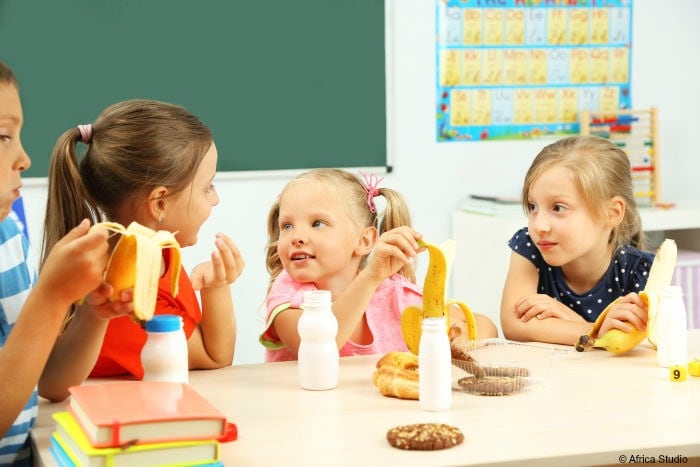By Guest Blogger Kelly Gunzenhauser
It was the weekend before school started, and one of the chores on my list is grocery shopping for lunches. My kids are older now and lunch is easier, but I remember the struggle with packing lunch for preschoolers.
Little fingers, tiny tummies, and picky palates make for a mealtime minefield. Here are some hints I’ve picked up during my years as a preschool teacher that may make packing lunch a more “ful-filling” experience.
Equipment
~ When picking out a lunch box, unzip it yourself. If you have trouble with the zipper, your child will, too.
~ Label everything! Children forget what their containers look like, and it takes a long time for teachers to memorize lunch boxes. The best way to do this is also the easiest—a Sharpie works great!
~ Inexpensive, plastic bento boxes are easier than small containers or baggies. One “help” and a child’s whole lunch is open. My favorites are the ones with compartments but no inside containers.
~ If you use baggies and containers, help your child practice opening them at home. It’s great motor skills practice for little hands!
~ Wash your child’s lunch box once in a while. This may seem obvious but it’s easy to forget to do it, and a child will stop eating if his lunch box smells.
Portions
~ Your clearest memories of lunch are probably from elementary school, but most preschool children just don’t eat that much at one sitting. Smaller portions are less overwhelming and may actually lead to more food being eaten.
~ A lot of preschool-age kids struggle to eat sandwiches. It’s a tall stack for a small mouth. See whether your child will eat a sandwich at home before sending one to school.
~ Little hands and little mouths = little food. If your child isn’t eating a lot of lunch, try making the foods smaller. Cut baby carrots and hot dogs into “sticks.” Remove the leaves from strawberries and slice them. Cut sandwiches into four squares or triangles.
~ Some containers (yogurt pouches and fruit cups, for example) can’t be sent home without making a huge mess, so you may not have a good idea of how much your child is eating. Ask teachers if you aren’t sure food is being eaten.
What Food to Include
~ Read labels if you have a nut-free school. Also, know what your school’s rules are; there is a difference between “Contains/may contain nuts,” and “Processed on equipment with nuts.”
~ If you send sun butter, keep a Sharpie handy so you can write “Sun butter!” on a sticky note and slap it on your child’s lunch. If a teacher can’t tell the difference and your school is nut-free, then the sandwich will come home.
~ Children are picky about food, right? Just know that a banana with lots of bruises, or apple slices that have turned brown, will probably not be eaten.
~ Even if you have a picky eater, plan some variety. When children bring the same exact things for lunch day after day, they get tired of it and may refuse to eat it, and that undermines your goal of introducing more foods. If you have a child who only eats a few things, include three of them and then add a small portion of something else. Eventually, it may get eaten! Teachers are usually happy to work with you on encouraging new foods.
~ Speaking of picky kids, you can always send breakfast for lunch. Scrambled eggs, waffles with syrup for dipping, toast with cheese, oatmeal, and dry cereal are all good choices.
~ When it comes to dessert, again, know your child. Some children diligently eat every bite before having dessert. Others ask over and over whether they have eaten enough; lunch becomes a battle to see how quickly they can get to the Oreos.
These are some of my favorite things to find in preschool lunches:
~ Sliced, peeled cucumbers, sprinkled with a touch of vinegar
~ Chips and guacamole or hummus
~ Halved grape tomatoes
~ Triangles of cheese quesadilla (add refried beans for a bonus protein punch)
~ Cheese cubes
~ Pepperoni
~ Blueberries, raspberries, or blackberries
~ A boiled egg
~ Rolls of lunch meat
~ Leftover chicken nuggets
~ Pickles and olives
~ Mini bagels (with cream cheese and jelly!)
~ Leftover pizza
~ Popcorn (good source of fiber)
~ Dried fruit like banana chips and cherries
~ For dessert, a simple Hershey’s kiss
Miscellaneous Tips
~ If you want to send a warm lunch, small Thermoses work just as well for this group as they do for older children.
~ Sending a spill-proof water bottle or juice box really helps teachers out. Even if your child can drink a whole bottle of water without spilling it, the child next to yours may send out an errant elbow, and that’s a lot of water to clean up!
~ Send all the sweet notes you want to in your child’s lunches. We love to read them to your kids! (Just be sure to use a permanent marker so the ink doesn’t run all over the place if something leaks.)

















I send my kids off with plenty of fruit. They LOVE apples and oranges. I also give them some good soup to take with them or toasted sandwiches. I pack them up with some yummy but healthy food.
I never would have even thought about so many of these. Thank you! Ready to send my littlest off next week!